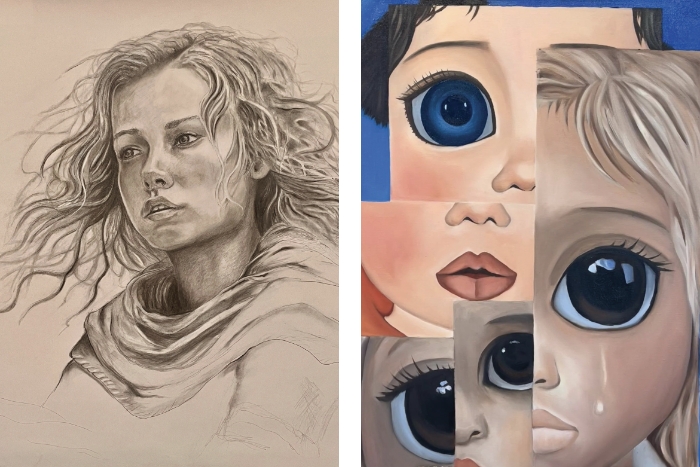
Trent Davis’s entries in the art contest: Birthplace (Bownes), which was intentionally designed to be forgettable (on the left), and Bownes, which was intended to be memorable (on the right). Birthplace (Bownes) placed 17th in the forgettable contest. Bownes did not place. (Images courtesy Brain Bridge Lab)
Trent Davis, AB’23, of the Brain Bridge Lab stages an art show for science.
“This isn’t a normal art exhibition,” were the first words Trent Davis, AB’23, said when I walked into The Art of Memory this past spring.
The exhibition, which Davis organized at Connect Gallery on 53rd Street, looked like an ordinary group show, with three walls of drawings and paintings, each labeled with its title and the artist’s name. But the show’s main purpose—as he wanted to explain right away—was to serve as a memory experiment.
The Art of Memory consisted of the 20 most memorable and 20 most forgettable artworks submitted in response to an open call. Unbeknownst to visitors, the most memorable works were all hung together on one wall. The most forgettable were hung on the opposite wall.
After seeing the show, visitors could take a test, using their phones, on which pieces they remembered seeing, and which ones they had forgotten.
Davis, who double-majored in neuroscience and visual art, curated the show while working as lab manager at the Brain Bridge Lab, run by Wilma Bainbridge, assistant professor of psychology. Bainbridge’s research focuses on memory, including the memorability of works of visual art. (See “You Must Remember This?” in Fall/24 University of Chicago Magazine.)
Davis explains how the contest worked, and whether his insider knowledge of memorability has influenced his own paintings. This interview has been edited and condensed.
Where did the art in the show come from?
Getting entries was one of the first big obstacles. I called a lot of art and community centers and listed the show on websites for artists. I also asked my friends who are artists here in Chicago.
Anyone was able to enter. We asked, “Do you consider yourself a professional or amateur, or somewhere in between?” It was a one-third, one-third, one-third split. Artists also had to choose whether they thought their artwork would be memorable or forgettable.
In one of the lab’s studies at the Art Institute of Chicago, artwork by famous artists was more memorable than artwork by less well-known artists. That raises the question, are these artists more successful because they have an intuition for what is memorable?
Is it hard to guess what will be memorable?
People are not great at predicting whether an image will be memorable or forgettable.
Some artists who entered the most memorable contest ended up placing in the most forgettable. They seemed a little upset.
How was the contest judged?
Through an online experiment—a very simple experiment. The 150 participants were shown a series of images and instructed to press a button on their keyboard whenever they saw an image repeated.
There’s an online platform with something like 150,000 people signed up. You can upload an experiment and they get paid to participate. That’s how the majority of our online human research is done.

So we tend to remember and forget the same artworks? It’s not influenced by what we’ve seen in the past or our own taste?
There’s some individual variation. But something about all the works on this wall makes them reliably memorable. On that wall, reliably forgettable.
When Wilma [Bainbridge] was in the space on opening night, she was like, which one was the most forgettable again? She had forgotten.
How did your own paintings do? They’re on a separate wall at the back.
I didn’t count mine in the experiment. But I was very surprised that my forgettable one made it into the top 20 forgettable artworks.
I was much more confident about the memorable one. I thought I’d make something very simple, centered, with text, because those are the trends we’ve seen as being more memorable. But apparently, I didn’t manage to do it.
